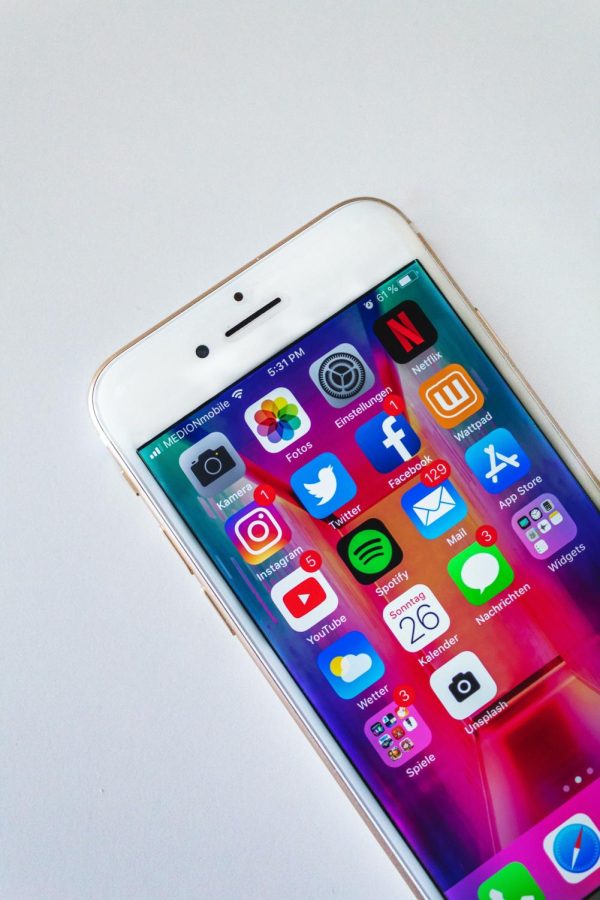The Highs and Lows of Cell Phone Use and Social Media
Phones have become a part of almost everyone’s everyday life. You can barely go anywhere without seeing one or using your own. We decided to send a survey to Nashoba students to gather information and feelings about phones and social media. In this survey, we asked our peers and teachers about their average screen time, what their phone distracts them from, and the positives of social media.
Social media provides you with the possibility to develop new relationships and the ability to meet people without having to travel to their location. You can see and hear a relative without traveling by using social media, and you can do it from the comfort of your own home or wherever you like. One student said, “It provides a great way to improve communication when in-person communication is not an option. It keeps you in the loop of things that are going on.” Many other students touched upon the same point. It seems like almost everyone is using social media for communication mainly, and to keep up with various topics.
One of the disadvantages of social media is that it can lead to depression and anxiety in users. According to a recent study by CAMH (Centre for Addiction and Mental Health), people who spend at least two hours every day on social media have a higher risk of mental health problems and psychological distress. Most social media users suffer from social anxiety or an overwhelming fear of social situations. Social anxiety and other mental health diseases boost feelings of loneliness, which enhances the need to use social media sites. This is the primary explanation for today’s young generation’s excessive use of social media.
Furthermore, social media bullying has long-term implications, including poor mental health. Not only does social media have a profound effect, but screen time, in general, does as well. With increased screen time comes risks for various health issues. Physical strain on the eyes has become a big problem. It’s more common now to see something called Computer Vision Syndrome. This causes blurred/double vision, red itchy eyes, headaches, back pain, and irritation. Because we live in such a technologically advanced world, much of our work is on a screen, further causing this. Along with the strain on our eyes, studies have seen increased sleep deprivation, risk of obesity, chronic health conditions, and loss of cognitive ability.
According to a survey The Regional sent out to Nashoba students, 45% of people use their phones for around 4 hours a day. More than 11.5% of students use their phones for over eight hours a day. Phones, in general, are known to be addictive. Whether it’s an Instagram notification or just the blue light our phones give off, the border between healthy and compulsive mobile use is thin. Too much reliance on a device might lead to mobile addiction. According to the National Library of Medicine’s scientific magazine, 6.3% of the population is addicted to their smartphone.
Phones supply us with a short cure for boredom. Without thinking, we pick up our phones to fill our free time. What used to be reading a magazine in a waiting room is now time to scroll on your favorite social media. Having easy access to so much information and so many apps has become an easy replacement for many hobbies. Now that we live in such a technologically advanced society, we are conditioned to use our devices. Especially due to Covid-19, more and more of our school work has become online.
Nearly everyone in response to The Regional’s survey said their phones were the main distraction for homework. One Nashoba student said, “I think my phone distracts me from concentrating. The ding it makes when I’m doing school work breaks my concentration.” The next two most common responses were sleep and family. Homework typically isn’t something seen as enjoyable. When your phone is right there it’s easy to get carried away and lose track of time. As for family, phones tend to lead to antisocial behavior because the social aspect of our lives can be satisfied virtually. We don’t find it necessary to go talk to our families anymore.
Our phones also distract us from sleep. Larry Rosen who is a psychology professor at California State University said, “We now know that the blue wavelength light from LED-based devices (phones, tablets, computers) increases the release of cortisol in the brain, which makes us more alert, and inhibits the production of melatonin, which is needed to fall asleep.” Not only the addictive scrolling of social media but the LED lights are keeping our brain awake, making us unable to sleep. There are many pros to social media. We are lucky to have such easy access to information, but it’s important to be aware of how much time we spend on social media and our screens.










